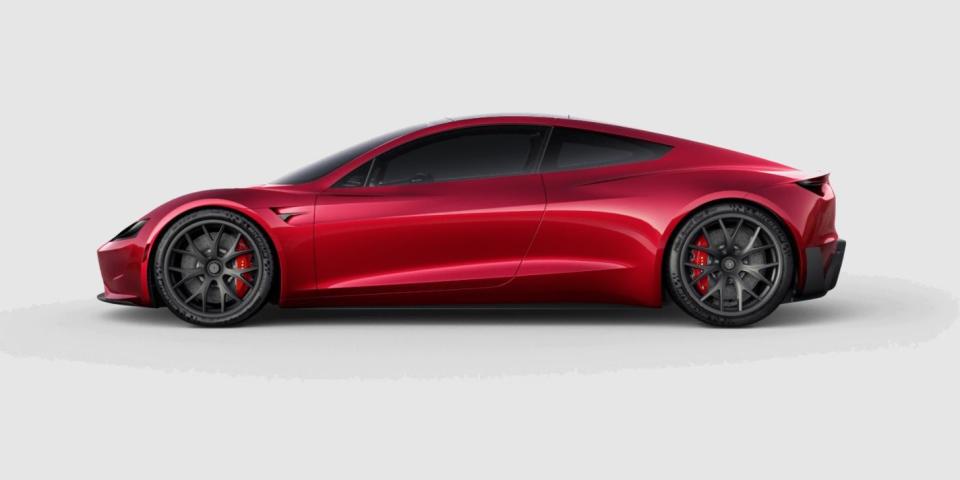Tesla Roadster Delayed a Little, Rockets Still Promised

Elon Musk says engineering for upcoming Tesla Roadster will be complete by the end of 2021, production expected to start in 2022.
Roadster is currently promised with a range of 621 miles, 1.9-second sprints to 60 mph and a 250 mph top speed.
Rocket-assisted handling could be accomplished by a composite overwrapped pressure vessel, experts say, but system is expected to be heavy and bulky.
Amid a busy week for Tesla, with the reveal of an updated Model S with an aircraft yoke for a steering wheel and a new interior, one other bit of news almost squeaked by. That bit of news was a long-awaited update on the long-awaited Tesla Roadster, promised all the way back in 2017 along with rocket-assisted handling, but had not been brought up for some time as Tesla focused on other things.
Tesla CEO Elon Musk added some clarity to the expected timeline for its release this week, and it probably won't surprise anyone, especially those who put down deposits for the Roadster, to learn it is now arriving later than promised, in 2022, Musk claims. However, the good news (especially for those who have put down $50,000 reservations for the Roadster) is that it will still have the promised rocket-assisted handling, which, admittedly, can mean a lot of different things. The $200,000 Roadster is claiming a 621-mile range, 8.8-second quarter mile times, a 250-mph top speed and 0 to 60 launches of 1.9 seconds.
The latest bit of news from Musk himself was sparked by what is no longer a surprising manner: a Twitter user simply asked Musk "What happened to the roadster?"
"Finishing engineering this year, production starts next year. Aiming to have release candidate design drivable late summer. Tri-motor drive system & advanced battery work were important precursors," Musk tweeted in response.
And in a tweet a day prior, Musk said that the "New Roadster is part rocket."
Finishing engineering this year, production starts next year. Aiming to have release candidate design drivable late summer. Tri-motor drive system & advanced battery work were important precursors.
— Elon Musk (@elonmusk) January 28, 2021
This means that Tesla is actually quite a bit further along in its development than had been thought for months (but is still late of course) when it was assumed that it would land sometime in 2023 because the company had other things on its plate, namely the Cybertruck and the Tesla Semi. The Cybertruck was thought to be a priority, given the awkward kind of fanfare its cyberpunk design received along with armor glass windows which did not turn out to be armored on stage, thus assuring pop-cultural sensation status.
In case you're wondering about the rocket part of the Roadster, there has been plenty of speculation about what exactly Tesla and Musk mean by "rockets," since The Boring Company's most notable product to date was a large propane torch billed as a flamethrower. So in light of what kind of marketing spin a propane torch received, there has been some disagreement in what the new Roadster's "rockets" might or might not be.
Musk actually shed some light on the rockets a couple of years ago.
"SpaceX option package for new Tesla Roadster will include ~10 small rocket thrusters arranged seamlessly around car," he tweeted in 2018. "These rocket engines dramatically improve acceleration, top speed, braking & cornering. Maybe they will even allow a Tesla to fly …"
The most plausible way that the Roadster could incorporate rockets into its bodywork, as a number of publications including Engineering Explained noted at the time, was through the use of a composite overwrapped pressure vessel that would send out pressurized air to 10 cold gas thrusters positioned at various points on the car. The system would be heavy, since pressurized air would have to be kept in a steel cylinder, and also quite bulky because it would need a lot of plumbing around the car in order to try to shift it a bit in response to handling. And it wouldn't be able to constantly fire its rockets to correct for handling.
If this is the manner in which Tesla envisions a rocket-assisted handling system for the Roadster, it could pull it off, but as Engineering Explained pointed out last year the tradeoffs in handling could be outweighed, quite literally in this case, by the weight of the system itself. And besides being a car with a composite overwrapped pressure vessel system in it, the Roadster would still have to be a usable electric car as well. So it can't really be a proof-of-concept prototype that disregards items like curb weight and passenger space.
But here's the thing: The Model S Plaid Plus sounds like it will offer most of the roadster's capability in a sedan wrapper, minus the rockets. So a lot of the tech of the Roadster is already going into the sedan, and it's expected to start shipping far sooner.
Does the Roadster need rockets at all? Sign up for comments and let us know.

 Yahoo Autos
Yahoo Autos 